Operational Characteristics of AlGaN/GaN High-Electron-Mobility Transistors with Various Dielectric Passivation Structures for High-Power and High-Frequency Operations: A Simulation Study
Abstract
:1. Introduction
2. Materials and Methods
3. Results
3.1. Matching Simulated and Measured Data for the Basic Si3N4 Entire Passivation Structure
3.2. Comparative Analysis of Entire Passivation Structures Based on Dielectric Materials
3.2.1. Simulation Results of the DC Characteristics
3.2.2. Simulation Results of the RF Characteristics
3.2.3. Simulation Results of the Hybrid Passivation Structure
3.3. Comparative Analysis of Partial Passivation Structures Based on Al2O3 and HfO2
3.3.1. Simulation Results of the DC Characteristics
3.3.2. Simulation Results of the RF Characteristics
4. Discussion
5. Conclusions
Author Contributions
Funding
Data Availability Statement
Conflicts of Interest
References
- Mishra, U.K.; Parikh, P.; Wu, Y.F. AlGaN/GaN HEMTs—An overview of device operation and applications. Proc. IEEE 2002, 90, 1022–1031. [Google Scholar] [CrossRef]
- Hamza, K.H.; Nirmal, D. A review of GaN HEMT broadband power amplifiers. AEU-Int. J. Electron. Commun. 2020, 116, 153040. [Google Scholar] [CrossRef]
- Levinshtein, M.E.; Rumyantsev, S.L.; Shur, M.S. (Eds.) Properties of Advanced Semiconductor Materials: GaN, AIN, InN, BN, SiC, SiGe; John Wiley & Sons: Hoboken, NJ, USA, 2001. [Google Scholar]
- Lenka, T.R.; Panda, A.K. Characteristics study of 2DEG transport properties of AlGaN/GaN and AlGaAs/GaAs-based HEMT. Semiconductors 2011, 45, 650–656. [Google Scholar] [CrossRef]
- Kranti, A.; Haldar, S.; Gupta, R.S. An accurate charge control model for spontaneous and piezoelectric polarization dependent two-dimensional electron gas sheet charge density of lattice-mismatched AlGaN/GaN HEMTs. Solid-State Electron. 2002, 46, 621–630. [Google Scholar]
- Sanyal, I.; Lin, E.S.; Wan, Y.C.; Chen, K.M.; Tu, P.T.; Yeh, P.C.; Chyi, J.I. AlInGaN/GaN HEMTs with high Johnson’s figure-of-merit on low resistivity silicon substrate. IEEE J. Electron. Devices Soc. 2020, 9, 130–136. [Google Scholar] [CrossRef]
- Augustine Fletcher, A.S.; Nirmal, D.; Arivazhagan, L.; Ajayan, J.; Varghese, A. Enhancement of Johnson figure of merit in III-V HEMT combined with discrete field plate and AlGaN blocking layer. Int. J. RF Microw. Comput.-Aided Eng. 2020, 30, e22040. [Google Scholar] [CrossRef]
- Liu, C.; Chor, E.F.; Tan, L.S. Enhanced device performance of AlGaN/GaN HEMTs using HfO2 high-k dielectric for surface passivation and gate oxide. Semicond. Sci. Technol. 2007, 22, 522. [Google Scholar] [CrossRef]
- Koveshnikov, S.; Tsai, W.; Ok, I.; Lee, J.C.; Torkanov, V.; Yakimov, M.; Oktyabrsky, S. Metal-oxide-semiconductor capacitors on GaAs with high-k gate oxide and amorphous silicon interface passivation layer. Appl. Phys. Lett. 2006, 88, 022106. [Google Scholar] [CrossRef]
- Kumar, M.; Gupta, S.; Venkataraman, V. Compact modeling of the effects of parasitic internal fringe capacitance on the threshold voltage of high-k gate-dielectric nanoscale SOI MOSFETs. IEEE Trans. Electron. Devices 2006, 53, 706–711. [Google Scholar] [CrossRef]
- Hanawa, H.; Onodera, H.; Nakajima, A.; Horio, K. Numerical Analysis of Breakdown Voltage Enhancement in AlGaN/GaN HEMTs With a High-k Passivation Layer. IEEE Trans. Electron. Devices 2014, 61, 769–775. [Google Scholar] [CrossRef]
- Jebalin, B.K.; Rekh, A.S.; Prajoon, P.; Kumar, N.; Nirmal, D. The influence of high-k passivation layer on breakdown voltage of Schottky AlGaN/GaN HEMTs. Microelectron. J. 2015, 46, 1387–1391. [Google Scholar] [CrossRef]
- Chander, S.; Gupta, S.; Gupta, M. Enhancement of breakdown voltage in AlGaN/GaN HEMT using passivation technique for microwave application. Superlattices Microstruct. 2018, 120, 217–222. [Google Scholar] [CrossRef]
- Choi, J.H.; Kang, W.S.; Kim, D.; Kim, J.H.; Lee, J.H.; Kim, K.Y.; Min, B.G.; Kang, D.M.; Kim, H.S. Enhanced operational characteristics attained by applying HfO2 as passivation in AlGaN/GaN high-electron-mobility transistors: A simulation study. Micromachines 2023, 14, 1101. [Google Scholar] [CrossRef] [PubMed]
- Liu, X.; Qin, J.; Chen, J.; Chen, J.; Wang, H. Novel stacked passivation structure for AlGaN/GaN HEMTs on silicon with high Johnson’s figures of merit. IEEE J. Electron Devices Soc. 2023, 11, 130–134. [Google Scholar] [CrossRef]
- Du, J.; Chen, N.; Pan, P.; Bai, Z.; Li, L.; Mo, J.; Yu, Q. High breakdown voltage AlGaN/GaN HEMT with high-K/low-K compound passivation. Electron. Lett. 2015, 51, 104–106. [Google Scholar] [CrossRef]
- Prasannanjaneyulu, B.; Karmalkar, S. Relative effectiveness of high-k passivation and gate-connected field plate techniques in enhancing GaN HEMT breakdown. Microelectron. Reliab. 2020, 110, 113698. [Google Scholar] [CrossRef]
- Wu, J.; Xu, C.; Fan, Y.; Liu, X.; Zhong, Z.; Yin, J.; Zhang, C.; Li, J.; Kang, J. TCAD study of high breakdown voltage AlGaN/GaN HEMTs with embedded passivation layer. J. Phys. D Appl. Phys. 2022, 55, 384001. [Google Scholar] [CrossRef]
- Yoon, H.S.; Min, B.G.; Lee, J.M.; Kang, D.M.; Ahn, H.K.; Kim, H.; Lim, J. Microwave Low-Noise Performance of 0.17 μm Gate-Length AlGaN/GaN HEMTs on SiC With Wide Head Double-Deck T-Shaped Gate. IEEE Electron Device Lett. 2016, 37, 1407–1410. [Google Scholar] [CrossRef]
- Ma, M.; Cao, Y.; Lv, H.; Wang, Z.; Zhang, X.; Chen, C.; Wu, L.; Lv, L.; Zheng, X.; Tian, W.; et al. Effect of acceptor traps in GaN buffer layer on breakdown performance of AlGaN/GaN HEMTs. Micromachines 2022, 14, 79. [Google Scholar] [CrossRef]
- Kang, W.-S.; Choi, J.-H.; Kim, D.; Kim, J.-H.; Lee, J.-H.; Min, B.-G.; Kang, D.M.; Choi, J.H.; Kim, H.-S. Optimization of gate-head-top/bottom lengths of AlGaN/GaN high-electron-mobility transistors with a gate-recessed structure for high-power operations: A simulation study. Micromachines 2023, 15, 57. [Google Scholar] [CrossRef]
- Silvaco, Inc. Material Dependent Physical Models. In Atlas User’s Manual Device Simulation Software; Silvaco Inc.: Santa Clara, CA, USA, 2016; pp. 519–523. [Google Scholar]
- Majumder, A.; Chatterjee, S.; Chatterjee, S.; Chaudhari, S.S.; Poddar, D.R. Optimization of small-signal model of GaN HEMT by using evolutionary algorithms. IEEE Microw. Wirel. Compon. Lett. 2017, 27, 362–364. [Google Scholar] [CrossRef]
- Clark, R.D. Emerging applications for high K materials in VLSI technology. Materials 2014, 7, 2913–2944. [Google Scholar] [CrossRef] [PubMed]
- Chang, Y.C.; Huang, M.L.; Chang, Y.H.; Lee, Y.J.; Chiu, H.C.; Kwo, J.; Hong, M. Atomic-layer-deposited Al2O3 and HfO2 on GaN: A comparative study on interfaces and electrical characteristics. Microelectron. Eng. 2011, 88, 1207–1210. [Google Scholar] [CrossRef]
- Yoon, H.S.; Min, B.G.; Lee, J.M.; Kang, D.M.; Ahn, H.K.; Kim, H.C.; Lim, J.W. Wide head T-shaped gate process for low-noise AlGaN/GaN HEMTs. In Proceedings of the CS MANTECH Conference, Scottsdale, AZ, USA, 18–21 May 2015; pp. 18–21. [Google Scholar]
- Selberherr, S. MOS device modeling at 77 K. IEEE Trans. Electron. Devices 1989, 36, 1464–1474. [Google Scholar] [CrossRef]
- Hanawa, H.; Satoh, Y.; Horio, K. Effects of buffer leakage current on breakdown characteristics in AlGaN/GaN HEMTs with a high-k passivation layer. Microelectron. Eng. 2015, 147, 96–99. [Google Scholar] [CrossRef]
- Lee, J.H.; Choi, J.H.; Kang, W.S.; Kim, D.; Min, B.G.; Kang, D.M.; Choi, J.H.; Kim, H.S. Analysis of Operational Characteristics of AlGaN/GaN High-Electron-Mobility Transistor with Various Slant-Gate-Based Structures: A Simulation Study. Micromachines 2022, 13, 1957. [Google Scholar] [CrossRef]

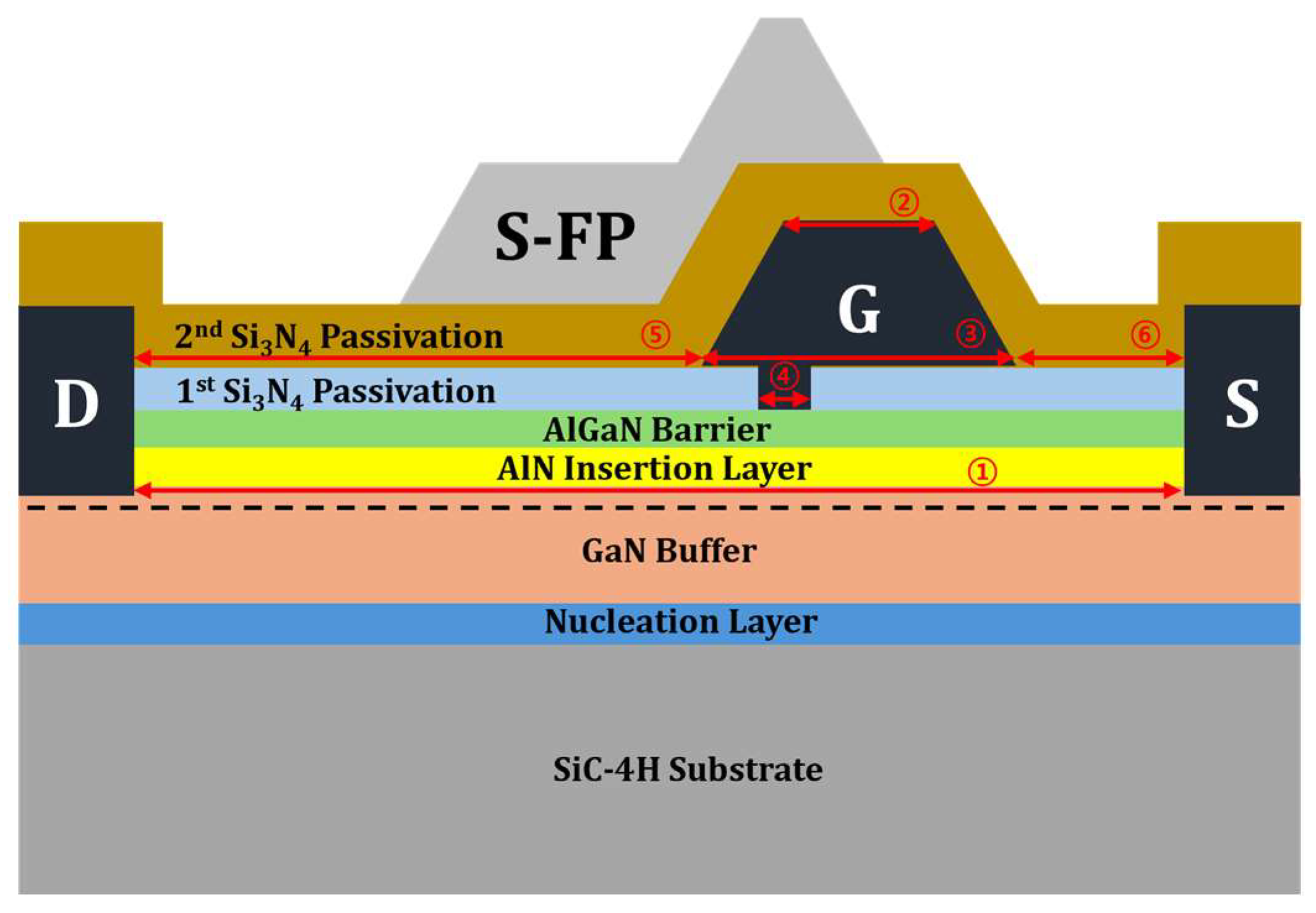


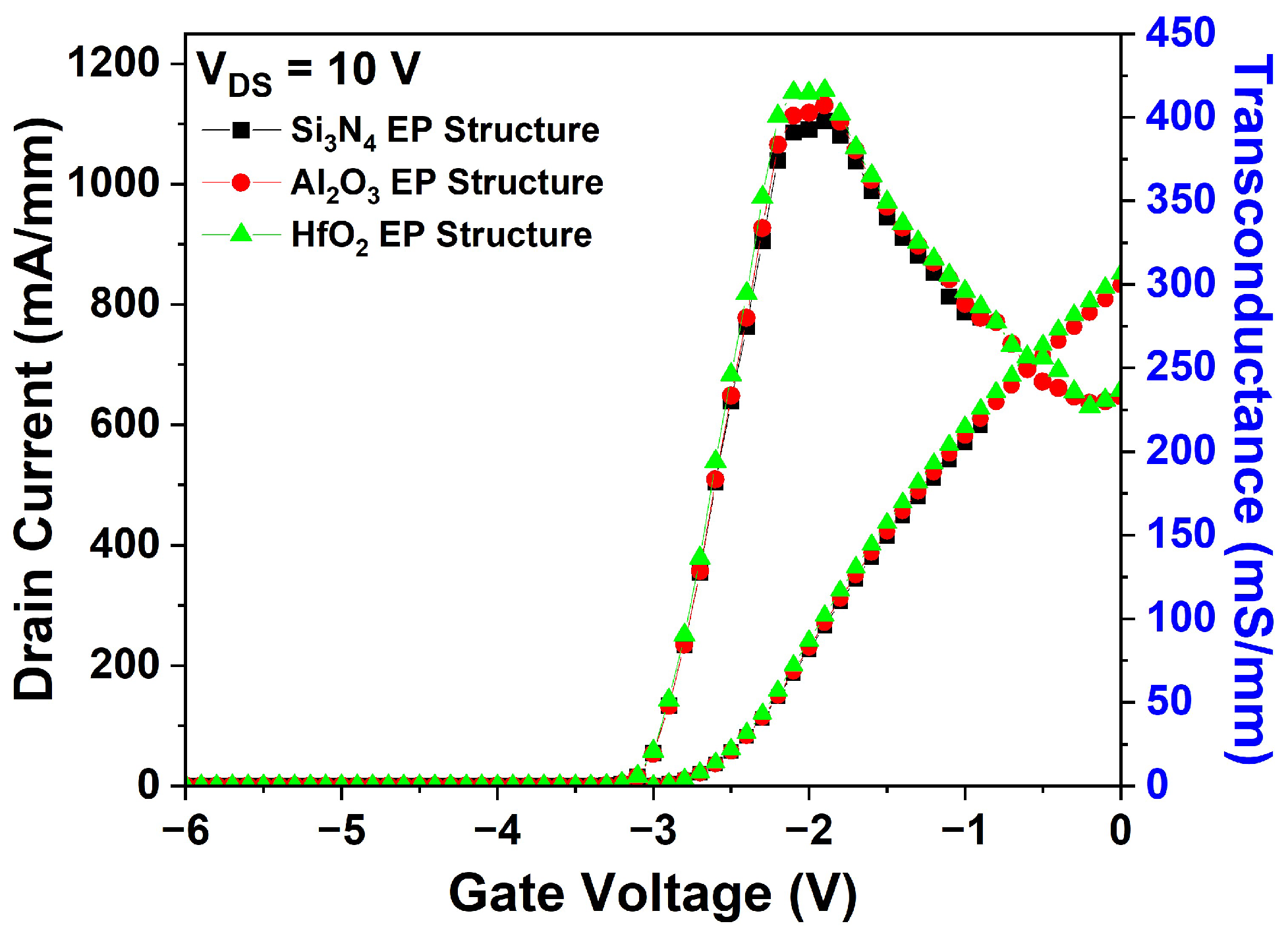


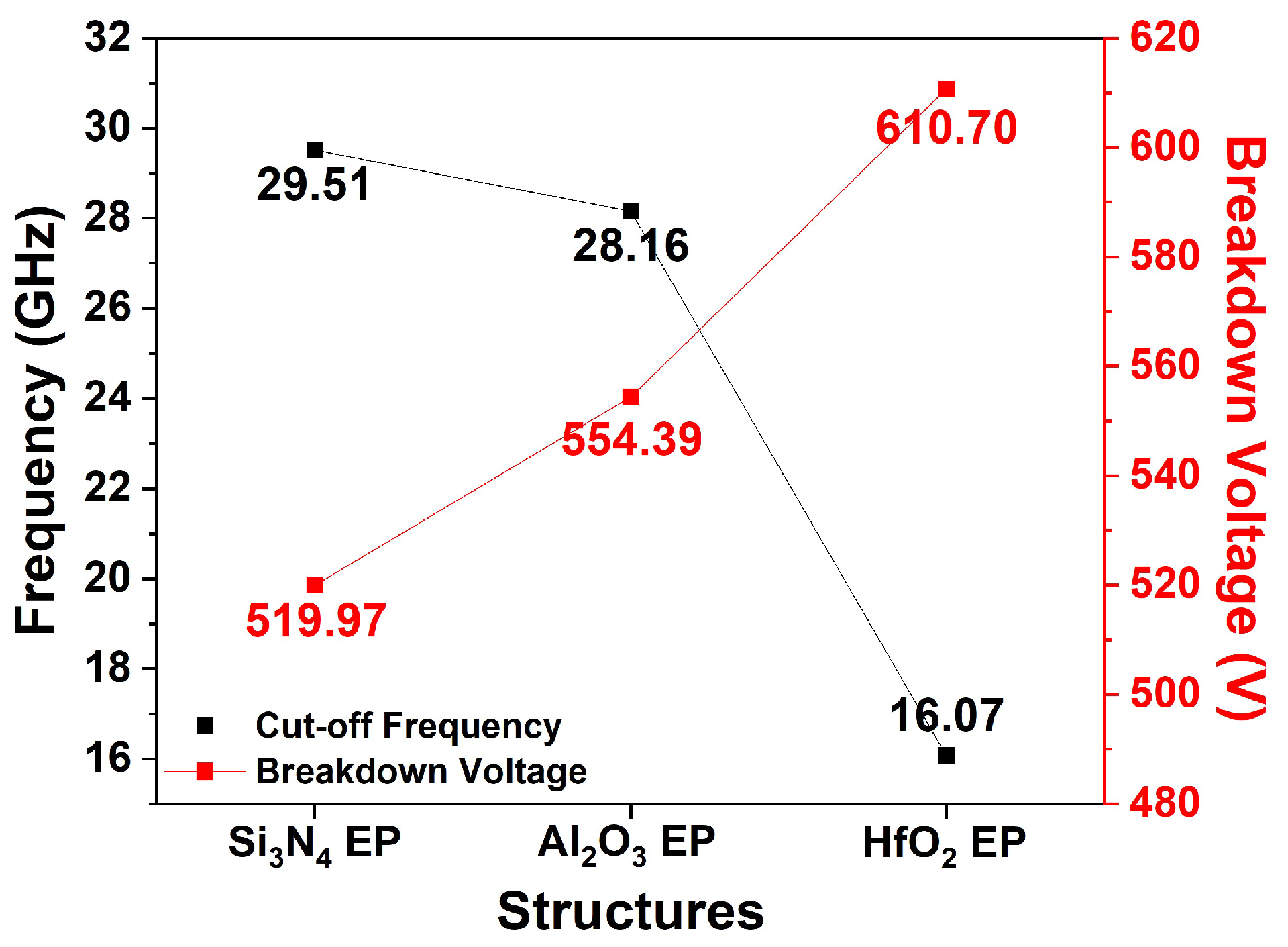

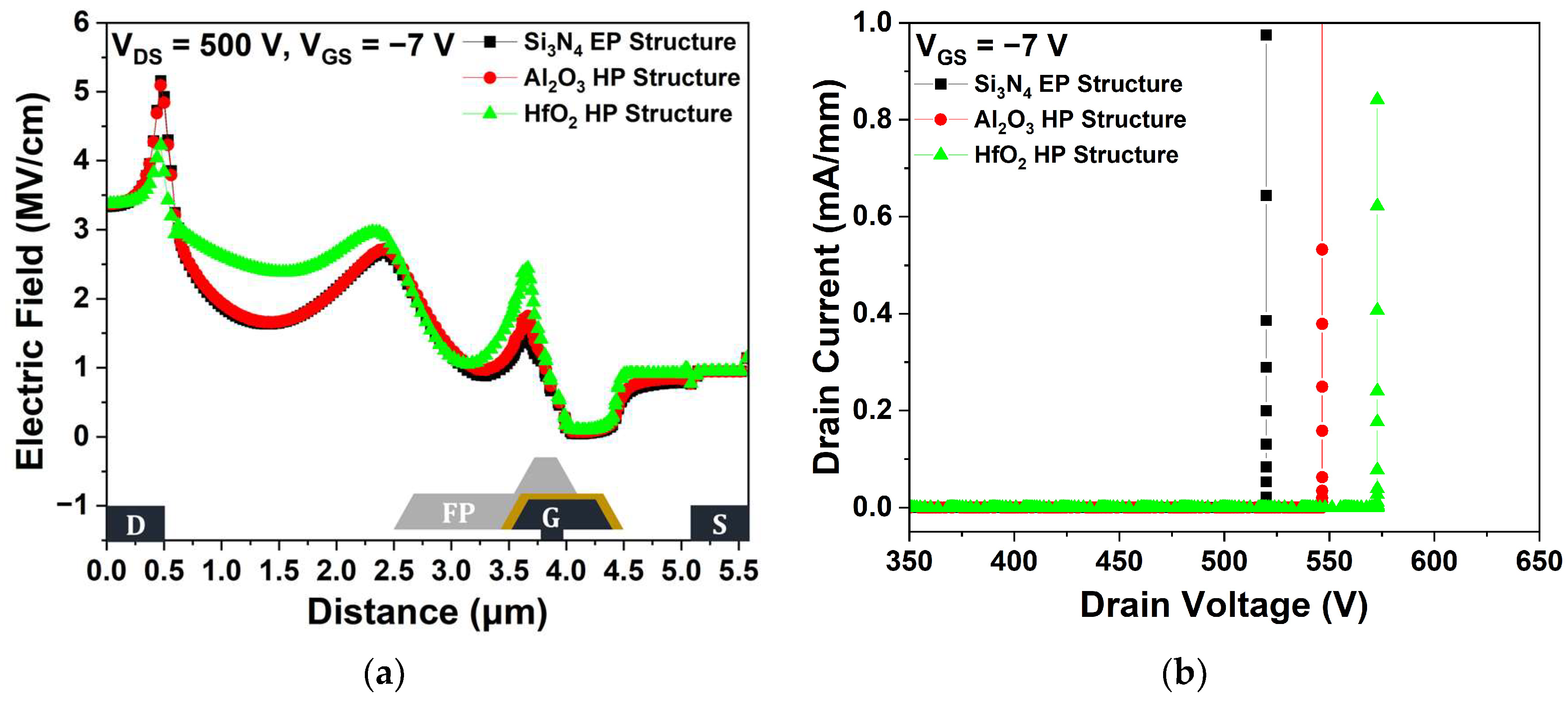
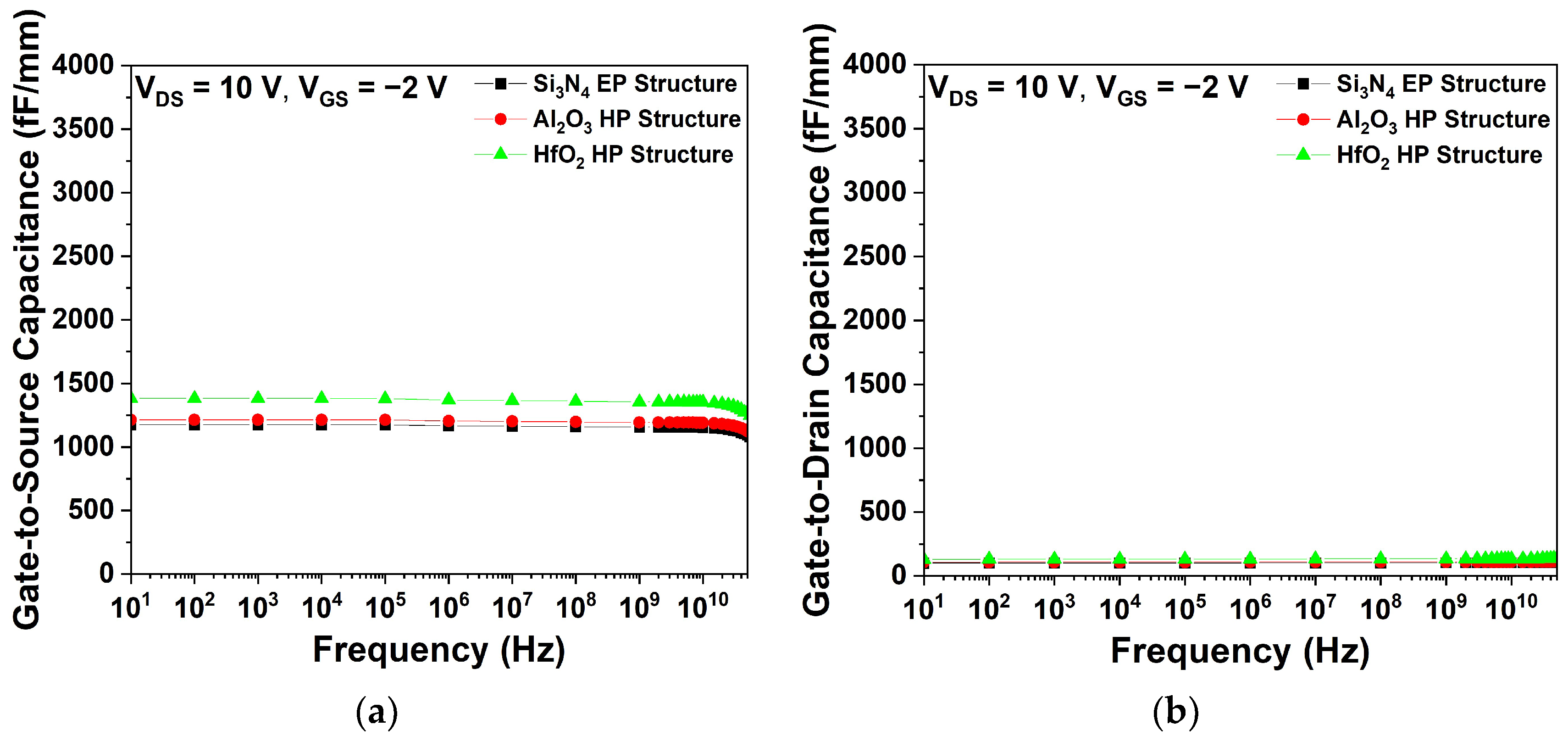

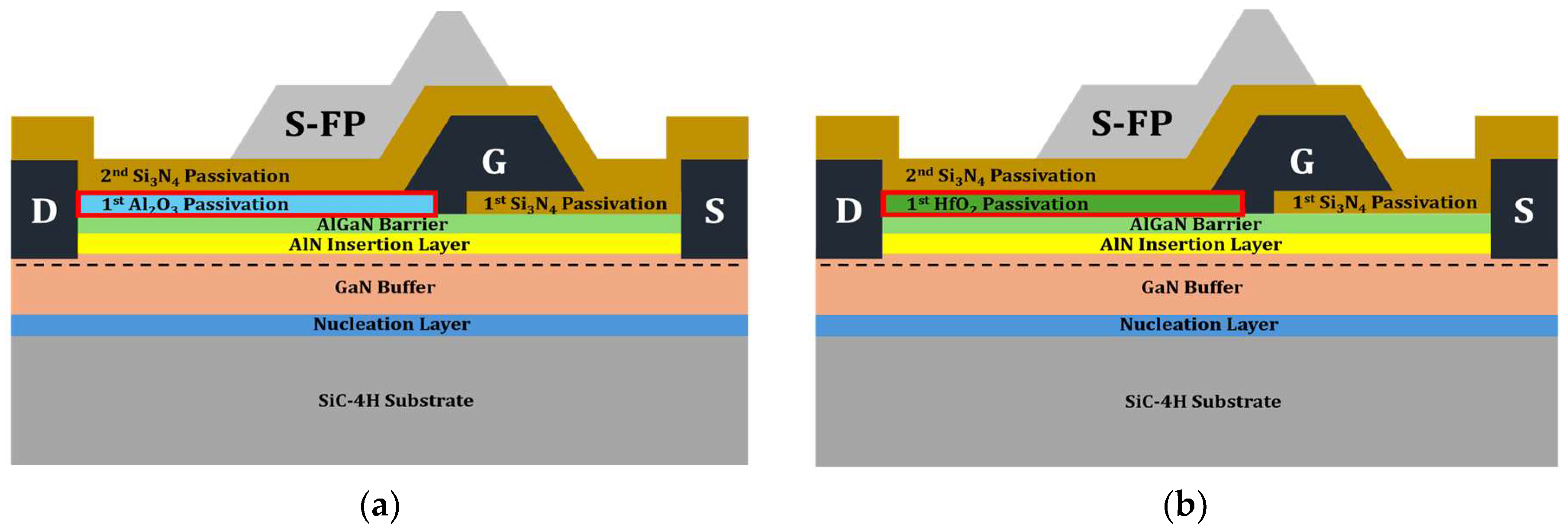
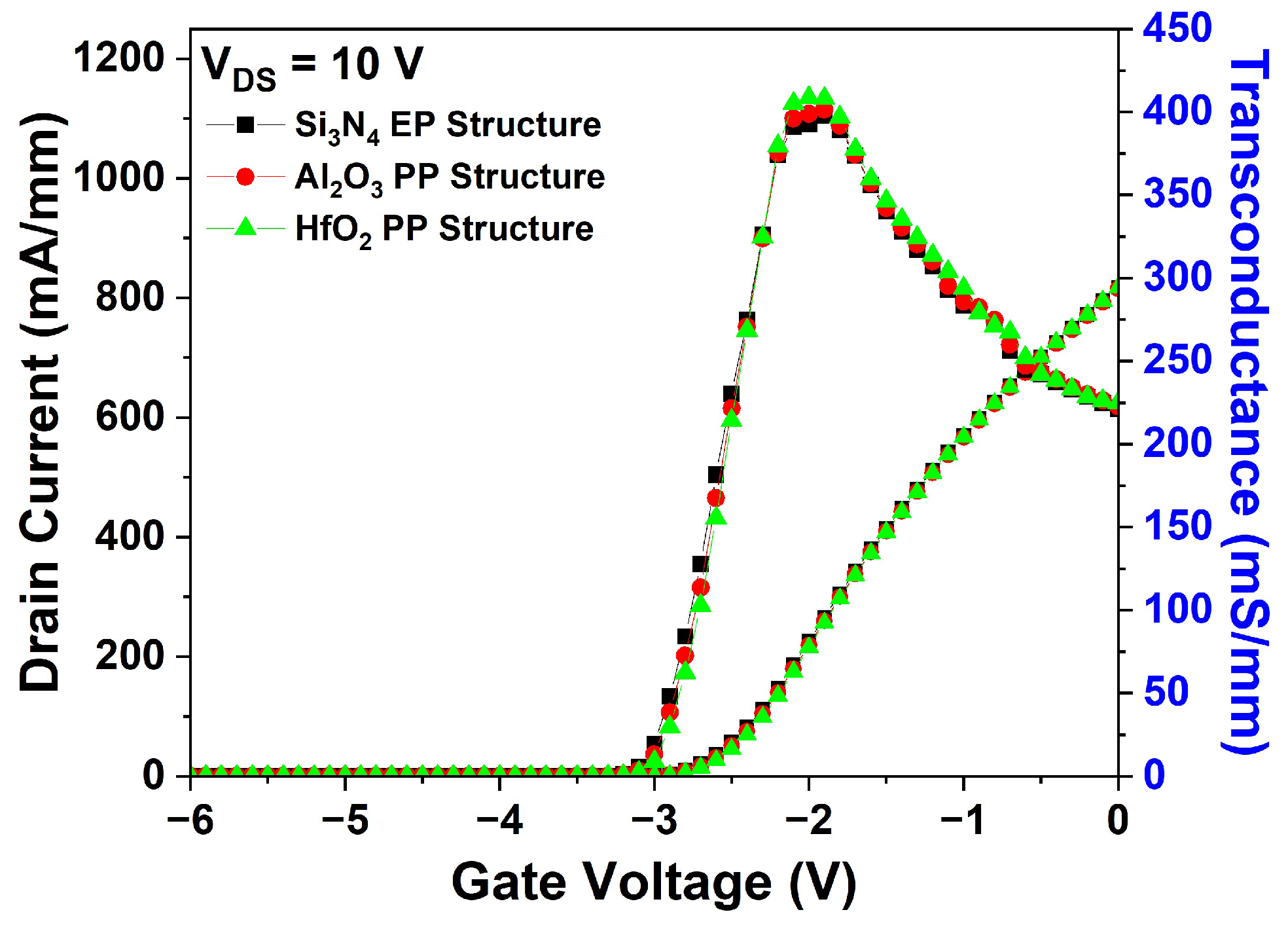
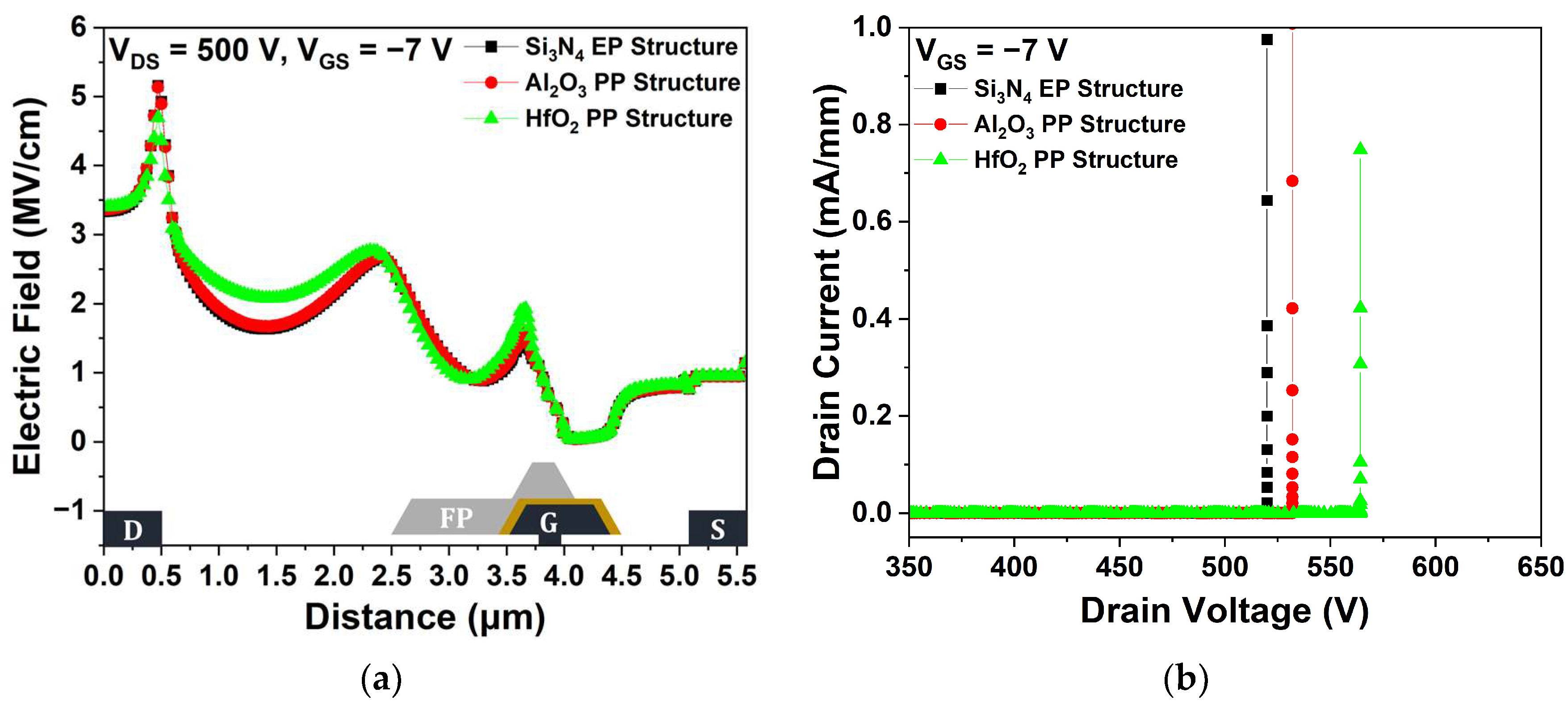
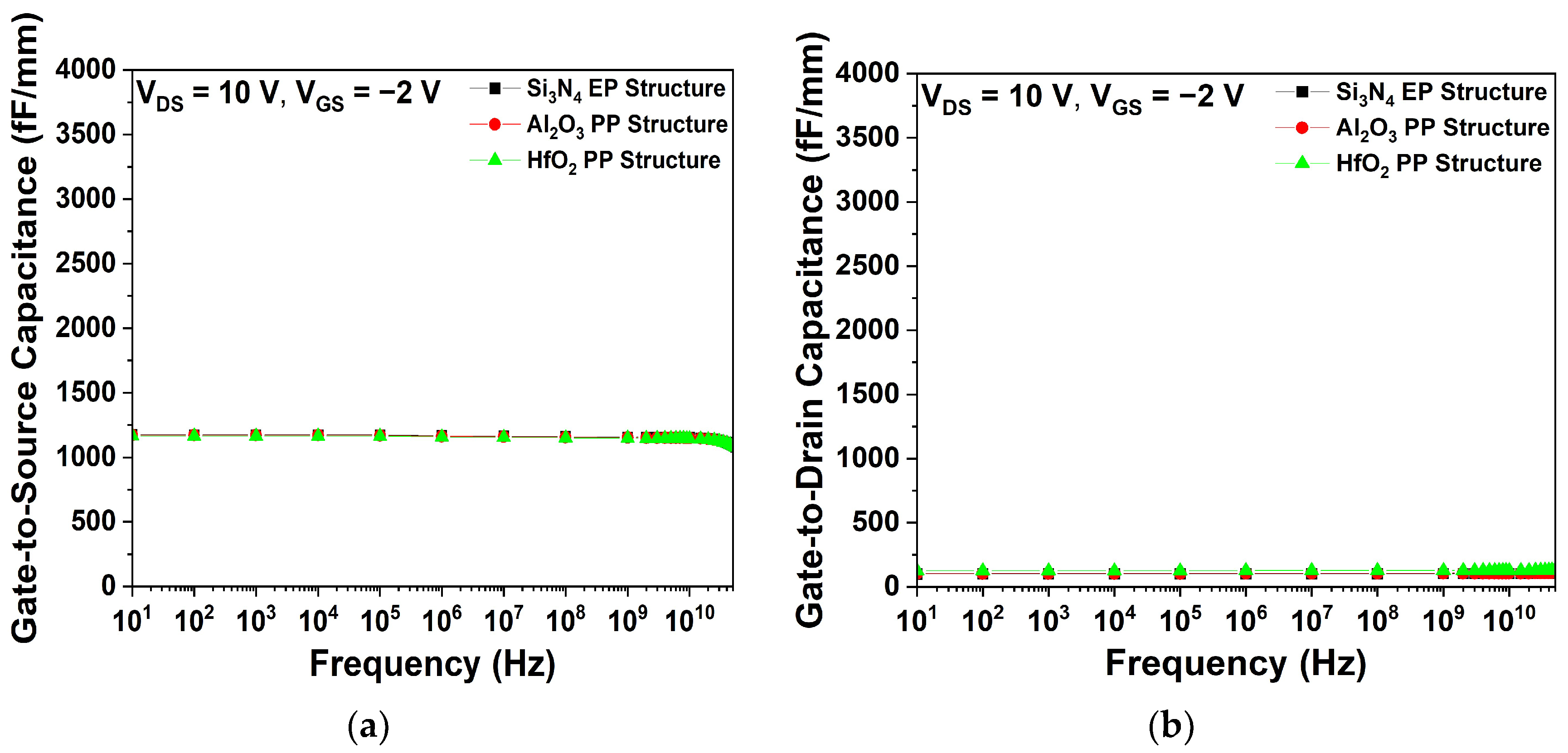

| Parameters | Value (μm) |
|---|---|
| ① LSource-Drain | 4.585 |
| ② LGate-Head-Top | 0.26 |
| ③ LGate-Head-Bottom | 0.71 |
| ④ LGate-Foot | 0.16 |
| ⑤ LGate-Drain | 3.175 |
| ⑥ LGate-Source | 0.7 |
| SiC-4H substrate | 5 |
| Nucleation layer | 0.02 |
| GaN buffer | 1.04 |
| AlN insertion layer | 0.001 |
| AlGaN barrier | 0.018 |
| 1st passivation | 0.02 |
| 2nd passivation | 0.25 |
| Parameters | Units | GaN | AlGaN |
|---|---|---|---|
| Bandgap energy | eV | 3.39 | 3.88 |
| Electron affinity | eV | 4.2 | 2.3 |
| Dielectric constant | - | 9.5 | 9.38 |
| Low-field electron mobility | - | Farahmand modified Caughey–Thomas Model | |
| High-field electron mobility | - | GANSAT Model | |
| Electron saturation velocity | cm/s | 1.9 × 107 | 1.12 × 107 |
| Hole saturation velocity | cm/s | 1.9 × 107 | 1.00 × 106 |
| Electron Shockley–Read–Hall lifetime | s | 1.0 × 10−8 | 1.0 × 10−8 |
| Hole Shockley–Read–Hall lifetime | s | 1.0 × 10−8 | 1.0 × 10−8 |
| Parameters | Units | Si3N4 | Al2O3 | HfO2 |
|---|---|---|---|---|
| Dielectric constant | - | ~7.5 | ~9 | ~25 |
| Bandgap energy | eV | 5.3 | 7.1 | 5.8 |
| Parameters | Units | Si3N4 | Al2O3 | HfO2 | ||||
|---|---|---|---|---|---|---|---|---|
| Structure type | - | EP | EP | HP | PP | EP | HP | PP |
| Peak electric field | MV/cm | 5.16 | 4.98 | 5.09 | 5.13 | 3.83 | 4.22 | 4.69 |
| Breakdown voltage (VBD) | V | 519.97 | 554.39 | 546.63 | 532.08 | 610.70 | 572.87 | 564.27 |
| Cut-off frequency (fT) | GHz | 29.51 | 28.16 | 28.63 | 29.44 | 16.07 | 26.46 | 29.37 |
| Johnson’s figure-of-merit (JFOM) | THz-V | 15.34 | 15.63 | 15.65 | 15.66 | 9.81 | 15.16 | 16.75 |
Disclaimer/Publisher’s Note: The statements, opinions and data contained in all publications are solely those of the individual author(s) and contributor(s) and not of MDPI and/or the editor(s). MDPI and/or the editor(s) disclaim responsibility for any injury to people or property resulting from any ideas, methods, instructions or products referred to in the content. |
© 2024 by the authors. Licensee MDPI, Basel, Switzerland. This article is an open access article distributed under the terms and conditions of the Creative Commons Attribution (CC BY) license (https://creativecommons.org/licenses/by/4.0/).
Share and Cite
Kim, J.-H.; Lim, C.-Y.; Lee, J.-H.; Choi, J.-H.; Min, B.-G.; Kang, D.M.; Kim, H.-S. Operational Characteristics of AlGaN/GaN High-Electron-Mobility Transistors with Various Dielectric Passivation Structures for High-Power and High-Frequency Operations: A Simulation Study. Micromachines 2024, 15, 1126. https://doi.org/10.3390/mi15091126
Kim J-H, Lim C-Y, Lee J-H, Choi J-H, Min B-G, Kang DM, Kim H-S. Operational Characteristics of AlGaN/GaN High-Electron-Mobility Transistors with Various Dielectric Passivation Structures for High-Power and High-Frequency Operations: A Simulation Study. Micromachines. 2024; 15(9):1126. https://doi.org/10.3390/mi15091126
Chicago/Turabian StyleKim, Ji-Hun, Chae-Yun Lim, Jae-Hun Lee, Jun-Hyeok Choi, Byoung-Gue Min, Dong Min Kang, and Hyun-Seok Kim. 2024. "Operational Characteristics of AlGaN/GaN High-Electron-Mobility Transistors with Various Dielectric Passivation Structures for High-Power and High-Frequency Operations: A Simulation Study" Micromachines 15, no. 9: 1126. https://doi.org/10.3390/mi15091126






